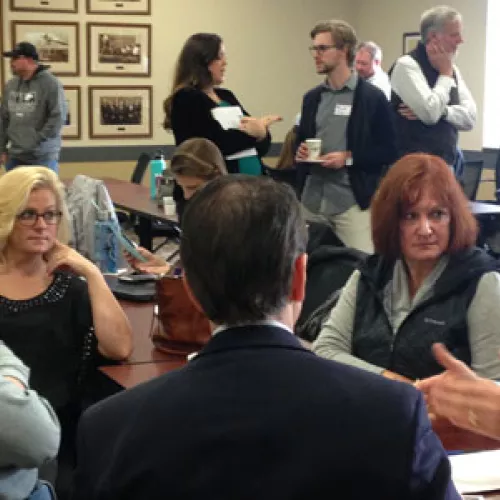Remember the movie Toy Story and that phrase, “To Infinity and Beyond!”? That was the basis for the name “Buildings, Benchmarks, and Beyond” or B3, and it was with that same sort of enthusiasm—but for energy efficiency—that Southeast Clean Energy Resource Team (SE CERT) kicked off a workshop on December 1st for local governments and schools looking to save energy in their buildings, kindly hosted at People’s Energy Cooperative in Oronoco.
Cheri Schneider of the Weidt Group started the session with a rapid-fire overview of the public building benchmarking part of B3. In short, Cheri’s key messages were that B3 benchmarking allows you and your decision makers to better understand how your buildings’ energy use compares with others. This FREE tool can help you prioritize your energy improvements and track how your actions are making a difference. You can read all about B3 in general (it has five key components: https://www.b3mn.org/) and dig into the public building energy (and water!) benchmarking part here: https://mn.b3benchmarking.com/.
The keynote for the morning was Kevin Johnson of Red Wing Public Schools. Kevin reviewed the range of opportunities facility managers could and should be considering, talked about the benefits of automation systems and energy benchmarking and highlighted internal policies that have helped the Red Wing school district lock in energy savings. Thanks to energy improvements, the Red Wing School District is saving $200,000 in energy costs. A few key items that jumped out at participants:
- District set points for temperatures—68 degrees for heating, 76 degrees for cooling
- No plug load items in classrooms—so no mini-fridges, electric portable heaters, coffee makers, etc.
- Computers that power down at 8 pm. Staff don’t have to think about it, it just happens.
- Have a heating system that learns how much lead time the building needs to heat up in the morning based on the outdoor temperature so it’s only on and heating long enough to get to the agreed upon set points.
- BTU per Square Foot per Heating Degree Day (BTU/SF/HDD) is the key number to know… it should be going down.
Kevin and Cheri both shared a few examples of things that might go wrong with a building—perhaps a duct is installed upside down, or maybe a systems is left in “open” mode when it should have been closed … you won’t know unless you’re looking and tracking.
We then transitioned to a panel discussion on engaging interns for help with your data entry and analysis. Alison Bettin, an Intern for La Cresent; Bill Waller, City Administrator of La Crescent; and Patrick Tebbe from Minnesota State University, Mankato shared a number of tips:
- Start by meeting with facilities folks
- Tour the buildings… understand where meters are located and what they power… what’s the building name vs the meter name?
- Get interns in their early years. They are anxious to learn and can put those skills to use. It doesn’t have to be a super technical project; it’s the real world experience that counts.
- Data can really help inform decision makers, and remember: clear, concise data is often more compelling than a long spreadsheet.
The last set of presentations was from CERTs staff members: Chris Meyer, SE CERT Regional Coordinator and Peter Lindstrom, Local Government Outreach Coordinator. They walked through examples for how to move projects forward – from energy assessment assistance to financing:
- RETAP – The Minnesota Retiree Environmental Technical Assistance Program (RETAP) employs skilled, retired professionals to provide facility assessments and community sustainability assistance to small businesses, institutions, and communities in Minnesota.
- Utility Rebates – Offered by most utilities for energy conservation and efficiency projects of all types and sizes.
- LEEP – The Local Energy Efficiency Program (LEEP) is a great way for local governments to evaluate facilities for energy savings. Local governments get technical assistance from the state to evaluate the best strategies to complete improvements. LEEP has a pre-qualified list of 10 contractors to complete an Investment Grade Audit (level 3 audit). Last but not least, LEEP helps local governments evaluate financing options to get the project done. There is a helpful one-pager on the program you can check out, too.
- GESP – The Guaranteed Energy Savings Program (GESP) utilizes performance contracts that leverage energy and operational savings to achieve deep energy efficiency improvements to public buildings. GESP enables local governments to utilize the technical expertise of the Department of Commerce as well as the contractual and financial documents developed by the state to identify and implement energy efficiency and renewable energy opportunities. Here’s a link to a one pager on the program and a Q&A with the City of Bemidji is a good read.
The meeting ended with a series of one-on-ones. This was a chance to visit directly with speakers, service providers, and resource folks to figure out how to tap these opportunities and bring those efforts home to work in other schools, cities, and county facilities. People lingered long after the event ended asking questions, sharing examples, and learning from each other. Turns out energy efficiency is fun!
If you weren’t able to join us, or did and want to follow-up, remember that Chris Meyer, Southeast CERT Coordinator ([email protected]) and Peter Lindstrom, CERTs Local Government Outreach Coordinator ([email protected]), are resources who are always available to assist you and help you connect the dots on a project to keep your efforts moving forward.
About the Local Government Energy Action Series:
This effort tells the stories of Minnesota municipalities, counties, and schools and the tangible results of their energy-saving efforts to inspire others to take their own actions.


